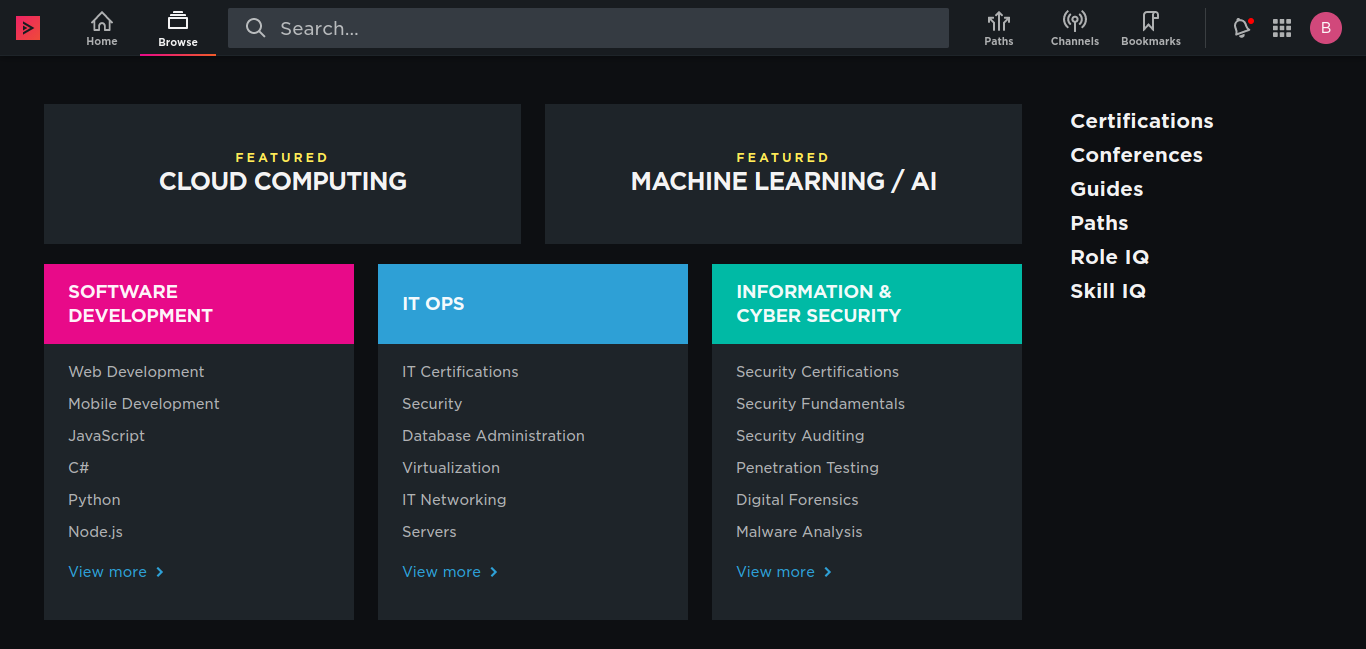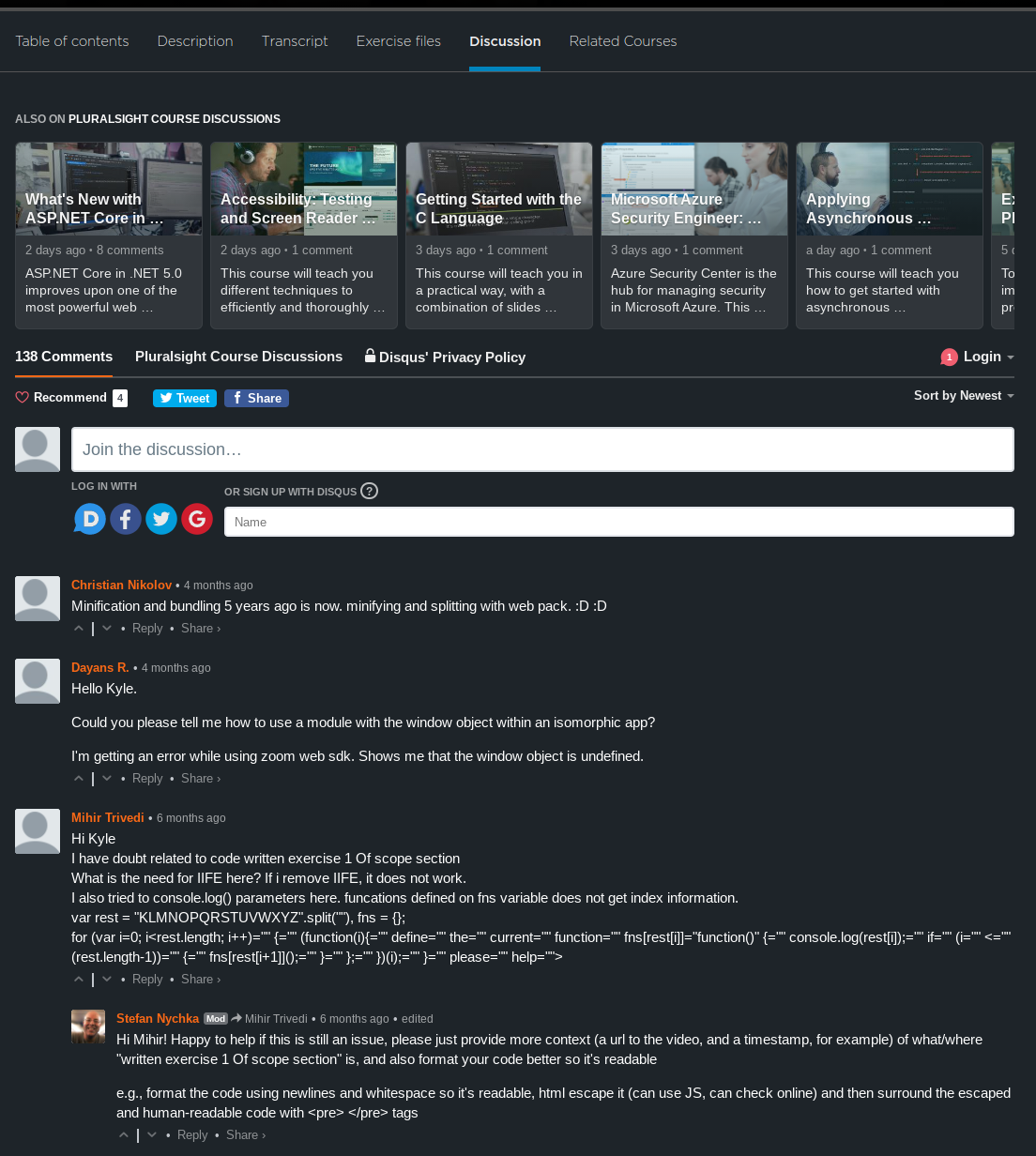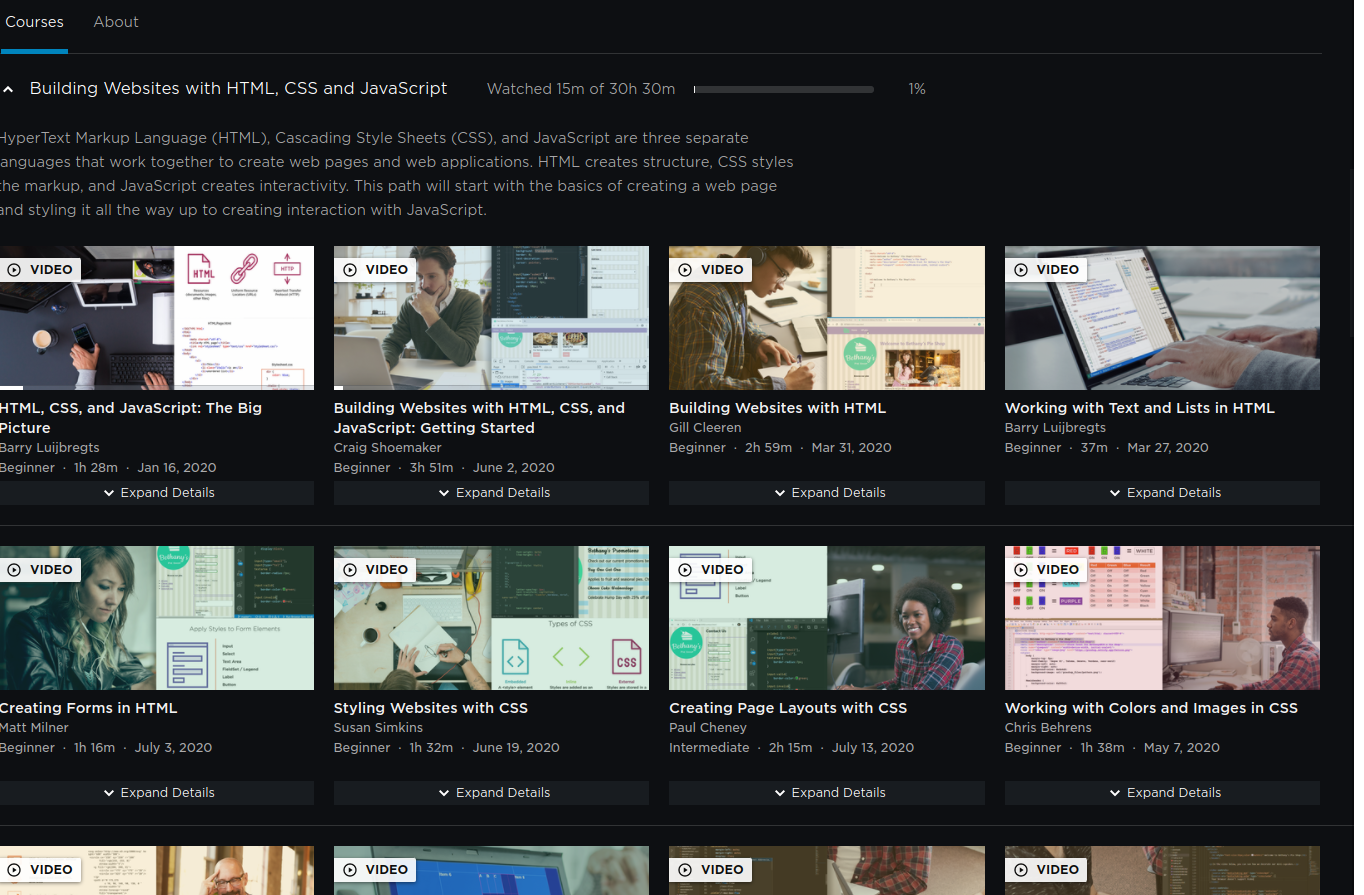Those who work in the tech industry are life-long learners. There are always more skills to gain and new developments to keep up with. If you’re a tech person, you want your learning to be as optimized as anything you design or build. Pluralsight has become such a major player in the online learning space over the last few years, but is it optimized for your needs?
Just because it’s a big, popular platform doesn’t mean it’s right for everyone. Throughout our Pluralsight review, we’ll go over everything you’ll need to know before making the informed decision as to whether Pluralsight will be worth it for you.
We’ll start with a quick overview of the platform and then dive into the company’s history, the kinds of courses they offer, and our thoughts about their content quality and features.
What Is Pluralsight?
Pluralsight is a tech education platform designed for industry professionals. It focuses on topics that those working in IT want to learn, from programming basics to the latest developments. If you’re looking for a platform that has lessons on a wider range of topics, we recommend looking at a platform like Skillshare, instead.
At the moment, most Pluralsight customers are businesses, which purchase subscriptions for their employees as part of professional development, but aspiring-programmers of all experience levels might be interested in signing up.
The vast majority of courses on Pluralsight are video-based and designed by expert authors, with a module-based structure and just enough repetition to make it easy to grasp difficult topics. The courses can be viewed individually but are also organized into what they call Paths, which are course playlists that take you from the basics up to advanced knowledge.
Pluralsight at a Glance:
- Video courses for tech professionals and programmers
- Over 7500 courses, with more constantly added
- Subscription model – pay a monthly or yearly fee for access to courses
- Strong business-to-business (B2B) focus with separate plans for companies
A Bit of Pluralsight History
Pluralsight was founded in 2004 by a group of developers from Utah, where the company is still based. Their initial focus was on giving in-person software and IT training for business employees, but after a little less than four years, they started introducing online courses, which became their main focus in 2010. The first batch of programming courses were written by the founders themselves!
Over the next decade, Pluralsight grew both as a company and as a platform, acquiring a lot of tech companies and e-learning platforms, and developing partnerships with tech giants like Microsoft and Adobe.
These days, the company employs over 1700 employees, and while we were writing this review, it was actually purchased by Vista Equities. We hope this will lead to a cash influx, expansions, and updates in the coming months, although we can’t know for sure if that’s what will happen.
Who Is Pluralsight Good For?
Pluralsight is almost all about IT and tech, with some adjacent topics, so it has a different appeal for different kinds of customers.
Companies
This platform truly shines as an enterprise solution. Giving your staff access to the platform is a great way to aid in their professional development, which in turn will make them a more valuable part of your team. We discuss the team plans and pricing and features in a bit more detail below.
Intermediate & Expert Developers
Pluralsight is a great platform for programmers and developers looking to boost their skills or to make lateral moves by picking up a new programming language.
It’s especially useful for front-end, back-end, or full-stack developers since there are many high-quality advanced courses covering relevant frameworks and programs. There are also great courses for those with some experience looking to learn more about cybersecurity, IT operations, or creative digital subjects like game dev or graphic design.
Is Pluralsight Good for Beginners?
If you’re a beginner, Pluralsight could be a fine choice or it could be overkill, depending on what you’re interested in learning.
If you’re aiming to learn a basic program or language for your own enjoyment, Pluralsight does the trick, but so do a lot of courses that can be bought individually (we discuss this a bit when comparing Pluralsight to Udemy below). On the other hand, if you’re ready to dive in with the aim of developing a career in tech, it can be a great option.
At your fingertips, you’ll have unlimited access to high-quality courses on all of the most in-demand programming languages and other tech-related topics. The website itself is incredibly intuitive and easy to navigate, with skill assessments that will guide you towards the perfect courses and course playlists. The beginner courses on JavaScript, HTML, and CSS are helpful for someone who is just starting out, and from there, there are endless directions to grow.
What Kind of Courses Does Pluralsight Offer?

There are over 7500 courses available on Pluralsight, many of which are sorted into playlists called Paths. While the average course is a few hours long, the Paths offer longer learning progressions that allow for organized development.
When signing on to the platform, you can simply search for whatever topic you’re interested in, but you can also browse through different categories and look at which courses are most popular.
How Much Is Pluralsight per Month?
As of the time of writing, these are the prices to sign up for Pluralsight.
Personal Plans
- Basic Monthly – $29
- Basic Annual – $299
- Premium Annual – $449
What Does the Premium Plan Include?
If you’re serious about your professional development, you might prefer Pluralsight’s premium plan over the more basic one. While the basic plan includes a lot of video course, the Premium includes added features that make the whole experience more interactive:
- Interactive lessons (in addition to video lessons) that allow you to put what you learn into practice
- Access to practice exams for different certification tests
- Projects that take interactivity to the next level by supporting you as you build your own real-world scenario.
Team Plans
- Professional $579 per person, per year
- Enterprise $779 per person, per year
What Do Team Plans Include?
Team plans include the same interactive courses as the personal premium plan, along with a few additional features that serve large organizations particularly well, like the ability to track usage and trend analytics, to know what topics your company’s employees are interested in and how much time they’re dedicating to their professional development.
Pluralsight Course Review

Pluralsight is incredibly user-friendly, just as we would expect from such a large company with so many tech experts on staff. You can simply browse through the courses and see what strikes your fancy, or you can let Pluralsight direct you, a little bit like Netflix, but for e-learning.
Course Structure
Most Pluralsight courses are video-based and follow a similar structure. They begin with the author introducing themselves and the topic they’ll be discussing, with a quick overview of what the course will cover.
Courses are broken down into short modules, so at the end of each module, the author will summarize the key principles and takeaways from the video. The organization and repetition make it quite easy for viewers to absorb information, although the entertainment factor varies from topic to topic.
Video Streaming Features
Video streaming is a major component of Pluralsight Courses and who well they work. We’ll examine the most noteworthy aspects of it here.
Speed Adjustment
Users can adjust the speed of the video (we found that watching the courses at 1.2x the speed was ideal for us). This can be especially helpful if you want to go more quickly through the introductory modules or if you want to slow down the video during more complex sections.
Notes
The note-taking feature is even cooler. As you watch a video, you can open the note-taking tab and record anything you want to remember. Your notes will be saved along with your timestamp in the video, so when you go back to look over your notes, they’ll be perfectly lined up with what they refer to.
If you find yourself unsure about something, this feature makes it really easy to write down questions and then return to the relevant section in the video. If you find one section of the video especially helpful, taking a note about that will also allow you to find it again easily at any point in the future.
Content Quality
At the end of the day, the quality of the content itself is the most important thing to consider. We’ll look at the key components below.
Authorship
Pluralsight’s process for vetting authors and adding courses to the platform is incredibly thorough at the outset. Unlike other platforms, Pluralsight authorship is quite exclusive. Pluralsight often reaches out to specific experts in different fields to ask them to put courses together, while in other cases, authors can apply to build a course.
The authors have proven, real-life experience working on the topic they’d like to teach, so you’re always learning from someone who is truly an expert. In addition to being vetted for their tech knowledge, they also have to audition to prove their teaching skills and charisma.
How Courses Are Vetted
After an author produces a course, it goes through an extensive vetting process, where editors refine and improve its watchability, and other Pluralsight authors peer-review the content. The result is that the courses (especially the newly released ones) are exceptionally well-produced with high-quality information.
Update Frequency
However, there are still some issues with course quality and consistency, which are largely a side-effect of Pluralsight’s massive portfolio.
Technology moves quickly, so information can fall out of date in the span of just a few months. While Pluralsight does try to keep track of things with a short survey at the end of every course, at the time of writing, their portfolio still includes a lot of courses that are years out of date. Those courses might have been exceptional when they were first released, but they lose a lot of their value when they aren’t updated.
How to Identify Out-of-Date Courses
Thankfully, the most popular topics are almost always up-to-date (with the exception of some of the introductory Python courses). The issue is most felt with the courses that are either more niche or less relevant to Pluralsight’s core user base.
It’s up to you as the user to check and make sure that you won’t accidentally spend too much time learning something that’s no longer relevant. The Discussions feature that we discuss below can be helpful for that, as would looking at the release-date for each course and its star-ratings.
This is the most major complaint users have about the service. Since Pluralsight is continuously growing and developing, we expect it’s the next thing they’ll attempt to remedy.
Notable Pluralsight Features
There are a few more Pluralsight features worth mentioning since they enhance user experience quite a bit.
RoleIQ
When you first join, you’re invited to take your RoleIQ, an assessment that checks your knowledge level is when it comes to a specific role. This is incredibly helpful for figuring out which courses will be right for you, especially if you’re joining Pluralsight with a specific career goal in mind.
There are 53 different potential roles, including UX Designer, Java Developer, Machine Learning Developer, Mobile Developer, and many others.
SkillIQ
If you’re a beginner interested in gaining general tech or programming skills, taking a RoleIQ assessment won’t be necessary. Instead, you might prefer to start with the more basic SkillIQ, which will assess you based on more specific skills, from your understanding of HTML to how good you are at using Microsoft Office.
Once you complete a skill assessment on a specific topic, you’ll be given an IQ and a ranking, and based on that, you’ll get Path recommendations.
Paths

Paths are one of Pluralsight’s most useful features. In combination with SkillIQ, they take the guessing game out of deciding which courses to take. A Path is basically a playlist of courses that come together in a comprehensive, cohesive syllabus.
There are hundreds of different Paths options, but with the help of SkillIQ, you can get recommendations that are tailored to your interests and existing knowledge base.
Another bonus is that the courses that are part of Paths are more likely to be up-to-date when compared to any randomly selected course.
Discussions
One of our favorite features was the discussion section for each course. The discussion is essentially a comments section, where users can leave their thoughts about a course or any specific questions they have.
The course authors often answer questions asked in the discussion, but it’s most helpful as a way of learning about other users’ experiences and thoughts about a course. If a course is out of date, it’s very likely that a user will mention that in the discussion, for instance.
The more popular courses generate very robust and educational discussions, but the more niche ones are less likely to get as much attention.
Channels
Channels are a Pluralsight functionality that allows you to essentially create your own Paths. You can select each course you come across and simply bookmark it, or you can organize it into your own self-designed progression.
This feature is especially useful with a Teams accounts on Pluralsight since the Channels you create can be shared with other users in a group. This way, a manager can have all of the people on their team take the same series of courses, which is fantastic for ensuring everyone you work with is proficient with the same knowledge or technologies.
Is Pluralsight Worth It in 2021?
In a strict dollar-per-course breakdown, Pluralsight is absolutely worthwhile, but whether it’ll be worth it for you as an individual wholly depends on how much time you want to spend learning and whether you’re even part of Pluralsight’s target audience. A $29 a month subscription gives a nearly endless amount of content, with more good than bad courses.
If you intend to go through two or three Paths over the course of a month or to watch 4-5 courses on different topics, it’ll end up offering a better bang-for-your-buck than platforms where you buy one course at a time.
Pros
- One of the best e-learning platforms for IT professionals
- Subscription model ideal for cross-subject learning or for doing many courses
- Assessments and learning paths make progression easy to determine
- Mainstream tech/programming courses exceptionally high quality
- Excellent business subscriptions
- Intuitive platform
- Nice video features, like notes and adjustable speeds
- Discussions allow users to communicate with others about each course
Cons
- Some courses don’t get updated as frequently as needed
- Some quality difference between popular topics and “throwaway” topics
- Video-based learning isn’t for everyone
Pluralsight vs. Udemy
Pluralsight’s biggest competitor is Udemy, so it makes sense to want a comparison of the two. Both platforms have a very large portfolio of courses, with many that are incredibly high quality and others that are a little less impressive.
Course Quality
In general, Pluralsight edges out Udemy for consistency in course quality, but that’s because Pluralsight has much fewer courses available as well as a more rigorous vetting process for authors.
Even so, both platforms have their winners and their duds. You should always look at recent course reviews before committing your time (and in Udemy’s case, money) to doing a course on either platform.
Subscription Model vs. Open Market
For most would-be learners, the biggest difference between the two platforms would be their pricing model, and how that translates to what you can learn. Whereas Pluralsight has a subscription-based model, Udemy is a pay-per-course.
If you’re interested in pursuing a few different courses on a variety of advanced IT topics all at once, Pluralsight might better bang for your buck at $29 a month. On the other hand, if you’re only interested in focusing on one topic at a time and you know exactly what it is you want to dive into, Udemy could be a better fit for you.
In general, a Udemy course is more comparable to a Pluralsight Path than a single course, although this can vary. The average Udemy course costs around $10-$15 (especially because of frequent sales), so if you think you plan to go through 2-3 courses over the course of a month, Pluralsight has the edge.
The other benefit is that with Pluralsight, if you don’t like a course, you can just jump over to a different course, whereas with Udemy you are pretty much stuck with what you purchased. It’s essentially the difference between renting the one film you want to watch to having access to a streaming platform like Netflix or Disney+.
Languages
One final difference worth pointing out is that because of Udemy’s crowd-sourced nature, there are courses available in many languages beyond English, while Pluralsight is a strictly English-language platform.
Does Pluralsight Give Certificates?
Pluralsight gives certifications for completion of any of its courses, no matter which plan you sign up with. However, whether those certificates hold any significance is a little more debatable. The consensus amongst most industry professionals is that proof of skill is more impressive than a certificate, so you should definitely focus on getting the most out of the content.
With that said, some of the certificates from Pluralsight can be submitted as continuing education credits to a wide range of professional organizations and accreditation bodies, including CompTIA for IT and security certifications, PMI for project management certification, and ISACA for information systems, as well as others. These credits are often prerequisites for taking certification exams with these organizations that will hold more weight with potential employers.
In other words, while Pluralsight’s certificates themselves are not especially prestigious, they can be an important tool towards supporting your professional development and boosting your resume.
Does Pluralsight Have Practice Tests?
Practice exams for certifications, along with interactive courses, are only available with an annual premium subscription or through a Team plan.
Pluralsight has a very wide range of certification prep courses, to which all users have access. If you’re considering taking a few different tests, this can be a huge benefit, since all of these prep courses will be available to you for the one-time payment.
Our Final Pluralsight Insights
All-in-all, Pluralsight is a robust platform that serves developers exceptionally well. While it’s not ideal for those with a more casual interest in programming, it’s perfect for industry professionals. Whether you’re looking to make a lateral move, expand on your existing IT knowledge, or give your employees new professional opportunities, it’s a fantastic e-learning platform to join.

